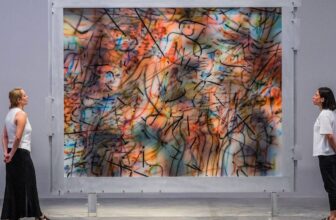Bridget Riley’s Most Famous Paintings
If you’ve ever stood in front of a painting and felt the walls of the gallery sway, the air vibrate, or your eyes dance across the surface, there’s a good chance you were looking at a Bridget Riley. Her art doesn’t just sit still, it moves, shimmers, and pulses with energy. Riley has spent over six decades exploring how color, line, and form can trick the eye and transform perception. She is one of the most important and influential figures in Op Art, a movement that takes the science of seeing and turns it into visual magic.
This story will guide you through who Bridget Riley is, her most famous works, the methods she uses, how much her paintings are worth, where they can be found, and why her art style has captivated the world.
The Story of Bridget Riley
Bridget Louise Riley was born on April 24, 1931, in Norwood, London, and grew up during the turbulence of World War II. Her early years were spent partly in Cornwall, where the landscapes, shifting seas, changing skies, and dazzling light, would later influence her sense of movement and color.
She studied at Goldsmiths’ College and later at the Royal College of Art in London, where she was exposed to both classical traditions and the daring innovations of modernism. By the 1960s, Riley had found her signature style: rhythmic, precise patterns that create optical effects, making the viewer’s eyes feel like they’re in motion.
What Was Bridget Riley Known For?
Bridget Riley is known for her pioneering work in Op Art, a style that uses geometry, contrast, and color relationships to create illusions of movement and vibration. She doesn’t simply paint an image; she creates an experience. Her works often appear to shift, undulate, or expand as you look at them.
Key hallmarks of Riley’s work:
Repetitive geometric patterns
Illusions of motion
Bold use of black-and-white (in her early work) and later, vibrant colors
Meticulous precision in execution
Her art is as much about perception as it is about painting. Riley has often compared her work to music, patterns and rhythms that play across the eyes instead of the ears.
Bridget Riley’s Most Famous Paintings
Bridget Riley has created hundreds of works, but several have become icons of 20th-century art. Some of her most famous include:
Movement in Squares (1961)
One of her earliest and most celebrated works. This black-and-white piece uses a grid of squares that gradually change in shape, creating the illusion of a bending plane. It was a breakthrough in her exploration of spatial distortion.
Current (1964)
A hypnotic series of undulating black-and-white wavy lines that seem to pulse. This painting appeared on the cover of The Responsive Eye, the catalog for the 1965 MoMA exhibition that introduced Op Art to the wider world.
Blaze 1 (1962)
A circular design of radiating zigzag lines that appear to rotate when you stare at them. It’s both mesmerizing and slightly disorienting, a hallmark of Riley’s optical mastery.
Cataract 3 (1967)
One of her first major color works, with sinuous stripes of red, blue, green, and white that ripple across the canvas, evoking the sensation of water in motion.
Fall (1963)
Vertical black-and-white lines that subtly curve, creating the illusion of depth and undulation.
Nataraja (1993)
Named after the Hindu god Shiva in his cosmic dance, this large canvas is filled with interweaving colored curves, showing Riley’s mature use of color harmonies.
How Much Do Bridget Riley’s Paintings Cost?
Bridget Riley is one of the most sought-after living artists in the world, and her works command significant prices at auction.
Smaller works, screen prints, and limited editions can range from $10,000 to $50,000.
Larger original paintings, especially from her 1960s black-and-white period, often sell for $500,000 to over $5 million.
Her auction record was set in 2016 when Chant 2 (1967) sold at Christie’s for £4.3 million (about $5.8 million USD at the time).
The high prices reflect not only her mastery and influence but also the scarcity of her early works, many are already in museum collections.
How Does Bridget Riley Make Her Paintings?
Riley’s paintings may look mechanical at first glance, but they are the result of an intensely personal and manual process. She does not use computers to design them; instead, she relies on drawing, testing, and meticulous planning.
Her process typically involves:
Concept and Studies – She begins with small drawings, experimenting with shapes, rhythms, and color sequences.
Color Trials – For her color works, she creates painted studies to test how colors interact. Riley is particularly sensitive to how adjacent colors affect each other’s brightness and hue.
Assistant Collaboration – Once the design is finalized, she works with assistants to transfer the pattern to a large canvas or panel with absolute precision. This ensures flawless execution of straight lines and curves.
Hand-Painting – Every surface is painted by hand with brushes, even though the result may look machine-made.
Riley once described her work as “closer to the method of a composer writing a score”, her assistants execute the work under her direction, much like musicians perform a composition.
How Many Paintings Does Bridget Riley Have?
There is no exact publicly available number, as Riley has been painting for over 60 years and continues to work actively. Her oeuvre includes:
Hundreds of paintings (large and small)
Numerous works on paper
Screen prints and limited editions
Wall murals and public commissions
Given the scale of her career, it’s safe to say she has created several hundred significant works. Many early works are in permanent collections, making them rarely available for sale.
What Art Style Is Bridget Riley Associated With?
Bridget Riley is most strongly associated with Op Art (short for Optical Art). This movement emerged in the 1960s and is characterized by:
Visual illusions
Geometric abstraction
Interaction of figure and ground
Perception-based effects
While Op Art had a short-lived moment in the fashion and design world of the 1960s, Riley remained committed to serious artistic exploration long after the trend faded. Her later work, particularly her color studies, bridges Op Art with color field painting and even elements of Minimalism.
What Materials Does Bridget Riley Use?
Riley works with traditional painting materials but applies them in extremely controlled ways.
Typical materials include:
Acrylic paint (especially in later works for its flat, even finish)
Oil paint (in some early works)
Canvas or linen supports
Graphite and gouache for preparatory drawings
Masking tape to ensure perfect edges
The choice of acrylic in later years allowed her to create crisp, flat areas of color without visible brushstrokes, enhancing the optical clarity.
Where Are Bridget Riley’s Paintings Located?
Riley’s works are held in major museums, galleries, and private collections worldwide.
Notable locations include:
The Museum of Modern Art (MoMA), New York – holds Current and other pieces.
Tate, London – houses Movement in Squares and a number of other works.
Centre Pompidou, Paris
Art Institute of Chicago
National Gallery of Australia
The British Council Collection
Private collections in Europe, North America, and Asia
She has also created site-specific wall paintings for institutions like the Tate Britain, which allow visitors to experience her work at architectural scale.
Bridget Riley’s Enduring Legacy
Bridget Riley’s art is not about telling stories in the traditional sense, it’s about the act of seeing. In her world, the viewer is an active participant; the painting comes alive only when your eyes interact with it. This makes her work timeless: as long as people can see, they can be fascinated by the visual games she plays.
Her influence extends beyond fine art:
Fashion – 1960s designers borrowed her patterns for clothing and textiles.
Graphic design – Her precise geometry inspired countless posters and album covers.
Architecture – Her wall works influence spatial perception in public spaces.
Even in her 90s, Riley continues to create, proving that the language of line and color is infinite.
Bridget Riley has given the art world something truly unique: paintings that breathe, vibrate, and move without ever actually moving. Her dedication to the science and poetry of perception has made her one of the greatest living painters, a figure whose work bridges the gap between human vision and artistic imagination.
From the hypnotic black-and-white works of the 1960s to her lush, rhythmic color compositions of recent decades, Riley’s career is a testament to the power of persistence, precision, and curiosity.
Quick Facts:
Famous for: Op Art, optical illusions in painting
Notable works: Movement in Squares, Current, Blaze 1, Cataract 3, Fall, Nataraja
Painting costs: $10k–$50k for prints; $500k–$5M+ for originals
Process: Careful studies, color trials, hand-painted execution with assistants
Number of works: Several hundred across 60+ years
Art style: Op Art (with elements of color field painting)
Materials: Acrylic, oil, canvas, masking tape, gouache
Locations: MoMA, Tate, Centre Pompidou, Art Institute of Chicago, National Gallery of Australia, and private collections worldwide




